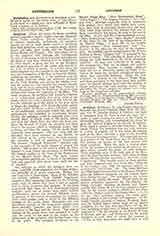

Antiphon. —(From the Greek antiphonon, sounding against, responsive sound, singing opposite, alternate chant; Latin, antiphona; French, antienne.) As at present commonly understood, an antiphon consists of one or more psalm verses or sentences from Holy Scripture which are sung or simply recited before and after each psalm and the Magnificat during Matins and Vespers. The verse which serves as the antiphon text contains the fundamental thought of the psalm to which it is sung, and indicates the point of view from which it is to be understood. In other words, it gives the key to the liturgical and mystical meaning of the psalm with regard to the feast on which it occurs. In a wider sense the name antiphon was also applied to the Introit, Offertory and Communion of the Mass in the early Church. Antiphona ad Introitum, i.e. the antiphon sung by the schola cantorum while the celebrant prepared for the Holy Sacrifice and during his solemn entry into the sanctuary, has become our present Introit. It is said to have originated with Pope Celestine I (432) who ordained that the Psalms of David be sung antiphonally before the beginning of the Mass. The verse serving as the antiphon text would be repeated on an independent melody after every verse of the psalm, which was sung to the end in that manner unless the celebrant gave the signal to the prior chorce to intone the doxology, with which the psalm ended, and after which the litany or Kyrie followed. Later, as the preliminary ceremonies which this elaborate performance was intended to accompany became shorter, the antiphon would be repeated after every second, third, or fourth verse of the psalm, before and after the Gloria Patri and after the Sicut erat. Since the Council of Trent the antiphon has been sung in the manner which is customary today, that is, before and after the psalm. Of the psalm itself, originally sung complete, only one verse and the doxology have been retained for any Introit, so that instead of the psalm being the main feature, the antiphon is now of paramount importance. The present “Graduale Romanum” contains only a few examples of the early manner of singing the Introit. One of these is the mode in which the Nunc Dimittis is sung during the ceremony of distributing the blessed candles on the feast of the Purification of the Blessed Virgin Mary. The verse, Lumen ad revelationem gentium etc., is chosen as the antiphon text and repeated after every verse until the end is reached.
The melodies to which the antiphon texts are sung, especially those preceding the Vesper psalms, are generally of a simple character. Seldom has any word two or three notes. Many of the melodies are entirely syllabic. Their melodic importance consists in their preparing the mind for the following psalm tune, to which they form a sort of prelude and of whose character they partake. It has been ascertained that there are only forty-seven typical melodies, each one of which, with slight melodic modifications, serves for several different texts. A remnant of the custom of repeating the antiphon after every psalm verse is found in the different endings of the psalm tunes. Sometimes one and sometimes another of the forty-seven typical antiphon melodies precedes any given psalm tune, according to the feast and the season. The various endings of the psalm tunes were intended to facilitate the entry on the part of the singers on the initial note of the antiphon, after having sung a verse of the psalm. The so-called antiphons of the Blessed Virgin Mary, “Alma Redemptoris Mater“, “Salve Regina“, “Ave Regina Coelorum”, and “Regina Coeli“, although originally sung in connection with psalms, from which they derive their name, have been sung as detached chants since the year 1239, when Pope Gregory IX ordered that one of them, according to the season, be sung at the end of the office. In a St. Gall MS. of the thirteenth century “Alma Redemptoris” and “Salve Regina” are part of the office for the feast of the Annunciation of the Blessed Virgin. A Paris MS. of the twelfth century assigns “Alma Redemptoris” and “Ave Regina” to the office for the feast of the Assumption. In a twelfth century antiphonary in St. Peter’s Basilica at Rome, “Regina Coeli” is assigned to the octave of Easter. The melodies to these texts are among the most beautiful in the whole Gregorian repertory. As they were intended to be sung by the congregation, they are of simple and graphic construction. They breathe a deeply religious spirit and are an efficacious means by which to reveal to the singer the mystical contents of the texts which they musically interpret. While the four antiphons in honor of the Blessed Virgin Mary and those occurring in the Mass have been prolific texts for figured settings both with the masters of classic polyphony and with modern writers, those preceding the Vesper psalms are almost universally sung to the Gregorian melodies.
JOSEPH OTTEN

